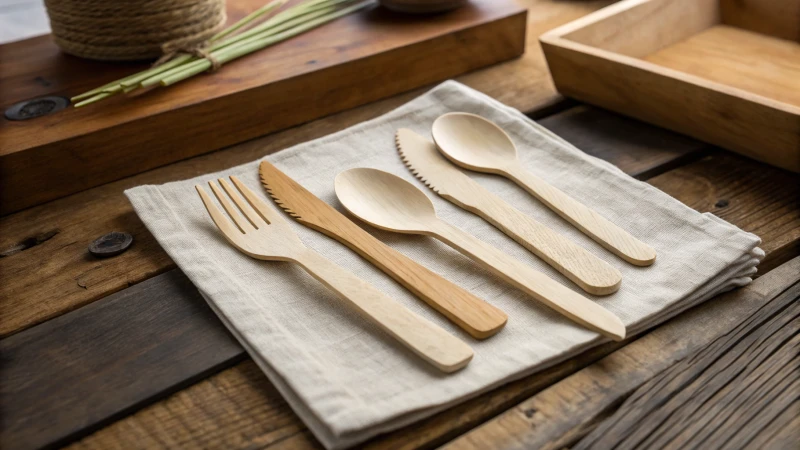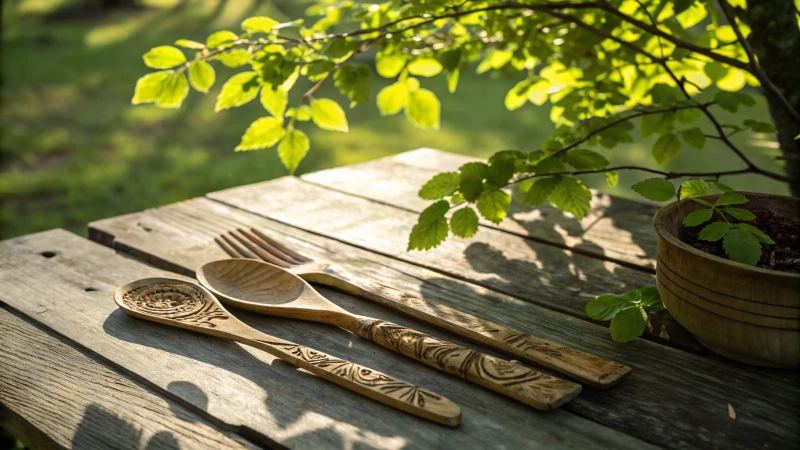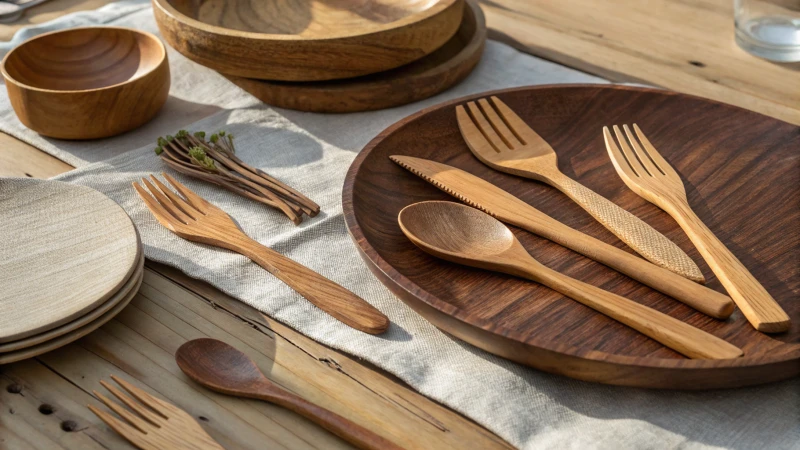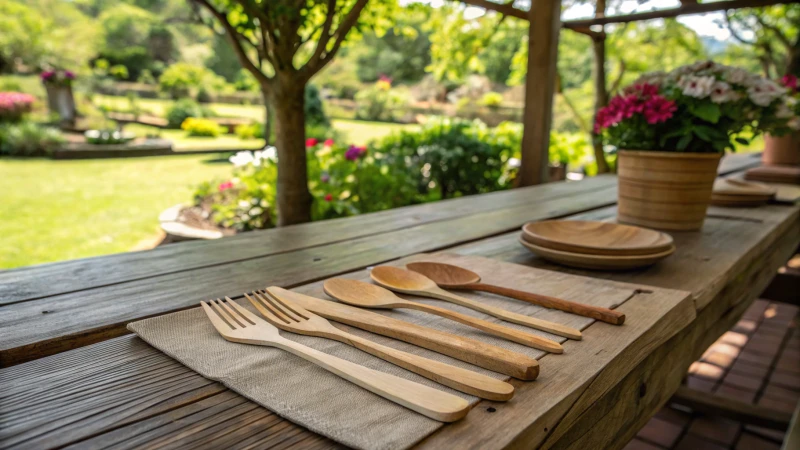
I remember my first encounter with wooden cutlery, and I was skeptical. Could something so simple truly replace metal or plastic?
Disposable wooden cutlery is generally easy to use, offering adequate strength and comfort for everyday dining needs. Its ergonomic design often provides a pleasant dining experience, although it may lack the precision of metal or the convenience of plastic alternatives.
Initially, I had my doubts. But over time, I've realized wooden cutlery's charm and utility. It’s not just about using a fork or knife; it's about embracing an eco-friendly lifestyle. Sure, it doesn’t have the sleekness of metal or the flexibility of plastic, but it holds its ground remarkably well in casual settings. Whether it’s a picnic in the park or a backyard barbecue, wooden cutlery steps up with surprising reliability and comfort.
Wooden cutlery is as precise as metal cutlery.False
Wooden cutlery lacks the precision of metal alternatives.
Wooden cutlery offers adequate strength for dining.True
Wooden cutlery provides sufficient strength for everyday use.
How Does Wooden Cutlery Compare to Plastic and Metal Alternatives?
Choosing the right cutlery might seem trivial, but trust me, it’s a decision that touches on sustainability, style, and practicality.
Wooden cutlery stands out as an eco-friendly option due to its biodegradability and unique aesthetic. While it’s more sustainable than plastic, it doesn’t match metal's durability. However, its lightweight nature makes it ideal for informal settings.

Sustainability Considerations
When I think about the cutlery choices that align with my values, sustainability is always at the forefront. Wooden cutlery naturally wins this round because it's biodegradable. Unlike plastic, which seems to hang around forever, wooden utensils break down and return to nature, which is a comforting thought. I often imagine the journey from tree to table to earth again—it feels like the circle of life. Plus, knowing that many wooden cutlery products are sourced from sustainably managed forests gives me peace of mind that I'm not contributing to deforestation.
In contrast, while metal cutlery, especially stainless steel, might not scream "eco-friendly" at first glance due to the energy involved in production, its incredible durability makes it a worthy contender. With proper care, these pieces can last for decades, offsetting the initial environmental impact. It's a bit like investing in a quality jacket that keeps you warm winter after winter.
Usability and Durability
Wooden vs. Plastic:
| Aspect | Wooden | Plastic |
|---|---|---|
| Comfort | Warm, Natural Feel | Lightweight, Smooth |
| Strength | Moderate | High |
| Usability | Biodegradable | Non-biodegradable |
Wooden cutlery offers a warm, natural feel that I find inviting. It's like holding a piece of nature in your hands while you eat. However, when faced with a hearty steak or dense foods, I find myself reaching for plastic due to its strength. While wooden options might falter under pressure, there's something charming about their simplicity.
Wooden vs. Metal:
Metal cutlery is the powerhouse of the utensil world—durable and reliable for any meal. But let's be real; who wants to lug around heavy metal utensils for a picnic? That's where wooden cutlery shines—perfect for casual settings like a sunny day at the park or takeout night at home.
Aesthetic Appeal
There's something undeniably charming about the rustic elegance of wooden cutlery. It brings a touch of nature to the table that resonates well with organic or eco-themed events. I love how it complements the vibe of upscale dining1 experiences or eco-conscious gatherings where presentation matters as much as the meal itself.
On the other hand, metal cutlery brings a sleek sophistication that's hard to beat when you're aiming for a fine dining feel. Meanwhile, plastic utensils offer flexibility in color and style but might not quite match up in the sophistication department.
Ultimately, choosing between these materials boils down to personal preference and specific needs. Whether it's sustainability goals (eco-friendly2), budget considerations, or creating just the right dining atmosphere, each type has its place in my collection.
Wooden cutlery is more eco-friendly than plastic.True
Wooden cutlery is biodegradable, reducing landfill waste, unlike plastic.
Metal cutlery is less durable than wooden cutlery.False
Metal cutlery, especially stainless steel, is highly durable and long-lasting.
What Are the Environmental Benefits of Using Wooden Cutlery?
I've always been on a mission to find simple ways to live more sustainably, and swapping plastic for wooden cutlery is one change that caught my eye.
Wooden cutlery is biodegradable and made from renewable resources, which helps reduce plastic pollution and conserves natural habitats. It supports sustainable forestry practices and decreases our reliance on non-renewable resources.

Biodegradability and Reduced Pollution
I remember attending a beach clean-up a few years ago, and the sheer amount of plastic waste was overwhelming. That's when I learned that wooden cutlery is a much friendlier option for our environment. Unlike plastic, which lingers for centuries, wooden forks and spoons break down naturally, so they won't clog our landfills or pollute oceans3, where plastic often harms marine life.
Renewable Resources and Sustainability
My grandfather used to tell me stories about the forests he visited as a boy, where trees were abundant and nature thrived. Today, I'm heartened to know that wooden cutlery comes from managed forests that follow sustainable practices, ensuring these beloved landscapes continue to flourish. These forests are regularly replanted, providing a continuous supply of wood without depleting the earth's natural resources4. Compared to fossil-fuel-based plastics, opting for wooden cutlery is like giving Mother Nature a helping hand.
Supporting Eco-friendly Practices
When I started my journey into sustainable living, I discovered that many wooden cutlery products are sourced from responsibly managed forests. This means that choosing wooden over plastic supports sustainable forestry5, balancing ecological health with economic viability. It's like supporting a system that preserves forest biodiversity while ensuring trees are harvested at a sustainable rate.
Energy Conservation and Reduced Carbon Footprint
During my research, I was pleasantly surprised to learn that producing wooden cutlery typically requires less energy than its plastic counterparts. This production process emits fewer greenhouse gases, contributing to a reduced carbon footprint. Plus, embracing wooden cutlery can stimulate demand for more energy-efficient production methods, which is a win for the planet.
Comparison Table: Wooden vs. Plastic Cutlery
| Feature | Wooden Cutlery | Plastic Cutlery |
|---|---|---|
| Decomposition | Biodegradable | Non-biodegradable |
| Resource Origin | Renewable (managed forests) | Non-renewable (fossil fuels) |
| Production Emissions | Lower carbon emissions | Higher carbon emissions |
| Environmental Impact | Supports habitat conservation | Contributes to pollution |
| Energy Consumption | Less energy-intensive | More energy-intensive |
Switching to wooden cutlery may seem like a small step, but every little bit helps when it comes to reducing our environmental impact. It's heartening to think that such a simple choice can contribute to conserving our planet for future generations.
Wooden cutlery is biodegradable.True
Wooden cutlery naturally decomposes, unlike plastic, reducing landfill waste.
Plastic cutlery supports sustainable forestry.False
Plastic is made from fossil fuels, not wood, and doesn't support forestry.
What Are the Downsides of Using Wooden Cutlery?
I remember the first time I switched to wooden cutlery, excited by the eco-friendly promise. But was it all smooth sailing? Let's dig into some potential hiccups.
While wooden cutlery is sustainable and biodegradable, potential drawbacks include splintering, limited durability, and sometimes a higher cost compared to plastic or metal alternatives.

Potential for Splintering
Have you ever had that moment of panic when a wooden fork feels a bit too rough? It turns out that one of the main issues with wooden cutlery is the risk of splintering. Unlike smooth plastic or durable metal, wooden utensils might develop splinters over time, which can be a bit unsettling during a meal.
| Material | Risk of Splintering |
|---|---|
| Wood | Moderate |
| Plastic | Low |
| Metal | Very Low |
The key here is the quality of craftsmanship. From my experience, investing in high-quality wooden cutlery6 can save you from those pesky splinters.
Durability Concerns
Picture this: you're hosting a cozy dinner party, and the last thing you want is your cutlery breaking mid-use. Wooden cutlery, though charming, generally doesn’t match up to metal when it comes to durability. They can break or wear down more easily, which is something to consider if you're planning to use them extensively.
- Metal Cutlery: Stands up well to high temperatures and repeated use without degrading.
- Wooden Cutlery: Ideal for single-use scenarios because of its biodegradable nature.
In my journey through the foodservice industry7, I’ve learned that balancing eco-friendliness with practicality is crucial.
Cost Implications
The appeal of sustainability can sometimes come with a heftier price tag. I've noticed that wooden cutlery often costs more than plastic due to the craftsmanship involved. For businesses on a budget, this can be a tough pill to swallow.
- Plastic Utensils: More affordable due to mass production capabilities.
- Wooden Utensils: Pricing varies based on quality and brand.
I found that exploring cost-effective suppliers8 can help strike a balance between environmental impact and budgetary constraints.
Hygienic Considerations
While I've generally found wooden cutlery safe, it does have a tendency to absorb moisture and could harbor bacteria if not treated or stored properly. This makes it essential for anyone purchasing wooden utensils to be aware of these risks.
For more insights on keeping wooden utensils hygienic, checking out resources on wood treatment methods9 can be helpful.
Understanding these potential drawbacks helps us make informed decisions about our choice of disposable cutlery.
Wooden cutlery poses a moderate splintering risk.True
Wooden cutlery can splinter if poorly crafted, unlike plastic or metal.
Metal cutlery is less durable than wooden cutlery.False
Metal cutlery is more durable and withstands high temperatures better.
Is Wooden Cutlery Hygienic and Compostable?
When I first heard about wooden cutlery as a replacement for plastic, my mind was filled with questions—chief among them, "Is it hygienic and truly compostable?" Let me share what I discovered on this journey toward eco-friendly dining.
Wooden cutlery is hygienic when properly treated and stored, and it's generally compostable. It decomposes naturally in compost environments, but checking for health standards and composting certifications is crucial to ensure its effectiveness and safety.

Understanding Wooden Cutlery Hygiene
The first time I picked up a set of wooden cutlery, I was at an outdoor market. There was something charmingly rustic about it, but the question of hygiene lingered in my mind. After some digging, I found that wooden cutlery can indeed be a safer choice than plastic, provided it's made correctly. Manufacturers treat the wood to ensure it's free from harmful chemicals, making it safe for food use. However, storing them properly is key—keeping them dry helps prevent any sneaky bacteria from setting up camp. To ensure you’re getting quality products, look for those with certifications like FDA approval10.
Factors Affecting Hygiene
- Manufacturing Process: The way wood is treated initially plays a big role in its hygiene.
- Storage Conditions: Keep your cutlery dry to avoid moisture-related problems.
- Surface Treatment: Make sure there’s no toxic varnish that could spoil your meal.
Compostability of Wooden Cutlery
What really excites me about wooden cutlery is its ability to return to nature with minimal fuss. I remember feeling a bit smug the first time I tossed my wooden fork into the compost bin, imagining it would soon become part of the earth again. Typically made from birch or bamboo, these utensils break down within about three months in a composting facility.
| Factor | Details |
|---|---|
| Material | Typically made from birch or bamboo |
| Decomposition Time | Around 90 days in industrial compost |
| Composting Needs | Requires proper composting conditions |
Ensuring Compostability
To make sure your wooden cutlery is compostable, check that it’s free from non-biodegradable coatings. Look for certifications like EN 1343211, which verify compostability standards.
Challenges and Considerations
- Industrial Composting Facilities: Not every place has facilities that can handle compostable cutlery effectively.
- Contaminants: Be cautious about tossing food-covered utensils into home compost piles.
By understanding these factors, I've been able to make more informed choices and integrate wooden cutlery into my lifestyle. It's all about balancing hygiene with our environmental goals—and feeling good about our choices along the way.
Wooden cutlery decomposes in 90 days in industrial compost.True
Wooden cutlery typically breaks down within 90 days under industrial composting conditions.
All wooden cutlery is FDA approved for food use.False
Not all wooden cutlery is FDA approved; it's essential to check for certification.
Conclusion
Disposable wooden cutlery is eco-friendly, comfortable, and strong enough for casual dining. While it lacks the durability of metal and precision of plastic, it offers a sustainable alternative.
-
Seeing examples of wooden cutlery in upscale settings showcases its aesthetic appeal. ↩
-
Exploring why wooden cutlery is biodegradable helps readers understand its sustainability benefits. ↩
-
Learn how plastic waste affects marine life and ecosystems. ↩
-
Discover why renewable resources are crucial for sustainability. ↩
-
Understand how sustainable forestry supports ecological balance. ↩
-
Discovering high-quality options reduces the risk of splintering and enhances user experience. ↩
-
Learn how sustainable practices are being integrated into foodservice industries. ↩
-
Find suppliers offering competitive pricing for quality wooden cutlery. ↩
-
Explore methods for treating wood to ensure safe and hygienic use. ↩
-
Ensures the wooden cutlery meets health and safety standards for food contact. ↩
-
This certification ensures products meet European standards for industrial compostability. ↩

